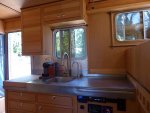GR8ADV
Explorer
Yeah what he said
Keep reading the next few days of the build diarie. I think it'll become more clear.
Sent from my QMV7A using Tapatalk
Yup will do. I am in great need of getting smarter. Thanks.
Yeah what he said
Keep reading the next few days of the build diarie. I think it'll become more clear.
Sent from my QMV7A using Tapatalk
I think the issue with direct mounting of an expo camper box to a fuso frame is that too much of the frame's twist would be transfered to the box.
...
I was surprised to read about a three point mount that was set up with the single mount b
ehindvtge cab and the two mounts at the rear. That would cause the most flex I would think and would result in a lot of movement between the cab and box. Switching it around with the pivot at the rear would work much better I would think.
Yup will do. I am in great need of getting smarter. Thanks.
GR8ADV
Your Unicell body is based on a truck cargo body designed to haul freight. These bodies are well built and are very stout. The floor is probability made out of 5/4 red oak with enough support to drive a loaded forklift on. Morgan makes a similar body here in the USA.
Considering where this truck has been; if during the renovation you didn't see any structure damage to the camper body, nor to the vehicle's frame rails, I'd load it up and hit the road. Just make sure there's support blocks in the frame 'C' channel where the rigid mounts are placed.
I don't understand why more people don't consider a truck cargo body and fitting out the interior themselves as the Greene's did. The truck and camper body have been around the world, retained its structural integrity, been renovated and can certainly do it again.
By the way, for what's its worth, I do like the placement of the windows up high as the Greene's designed it. While it limits the ability to place cabinets above the windows, you don't have to bend over to look out when standing up, as in a typical RV.
By the way, for what's its worth, I do like the placement of the windows up high as the Greene's designed it. While it limits the ability to place cabinets above the windows, you don't have to bend over to look out when standing up, as in a typical RV.

GR8ADV
Your Unicell body is based on a truck cargo body designed to haul freight. These bodies are well built and are very stout. The floor is probability made out of 5/4 red oak with enough support to drive a loaded forklift on. Morgan makes a similar body here in the USA.
Considering where this truck has been; if during the renovation you didn't see any structure damage to the camper body, nor to the vehicle's frame rails, I'd load it up and hit the road. Just make sure there's support blocks in the frame 'C' channel where the rigid mounts are placed.
I don't understand why more people don't consider a truck cargo body and fitting out the interior themselves as the Greene's did. The truck and camper body have been around the world, retained its structural integrity, been renovated and can certainly do it again.
By the way, for what's its worth, I do like the placement of the windows up high as the Greene's designed it. While it limits the ability to place cabinets above the windows, you don't have to bend over to look out when standing up, as in a typical RV.
I am not sure how 'off-road' the Greenes got. For all I know they may have not done much to flex the frame. One can travel to much of the world without getting too crazy. AK to South America without leaving pavement is pretty straight fwd if one wants to. So heck, I may blow it all up with one creative trip down to Baja.
I think having three frames break on you should make you the expert! Congrats!
I was thinking about the Fuso issue and wonder if the problem with using a three point mount on it is that perhaps it allows too much frame flex - i.e. more twisting than the Fuso was designed for since they expected a fixed bed to be installed on it. The three point mount also results in point loading where the two "outer" mounts are made. A spring mount might be the best option - restricting the frame's twisting but still allowing some to occur. It also eliminates point loading under normal conditions since the rear box lays on the frame rail normally.
Unimogs were designed to use a three point mount and are more substantial in dimensions and are probably better steel as well. So what works on a Unimog won't necessarily work on a Fuso.
If the cabin is designed with enough rigidity the issue of torsion-free mounting by using a three point mount might not be as important - the main benefit of the three point mount is less need for rigidity in the cabin - but if you already have it then you might not need the three point mounting system as much?
